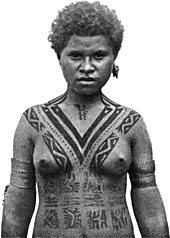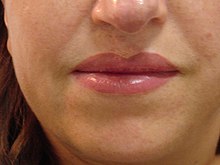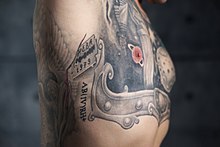The American Academy of Dermatology distinguishes five types of tattoos:[4] traumatic tattoos, also called "natural tattoos", that result from injuries, especially asphalt from road injuries or pencil lead; amateur tattoos; professional tattoos, both via traditional methods and modern tattoo machines; cosmetic tattoos, also known as "permanent makeup"; and medical tattoos.
Traumatic tattoos[edit]
| This section needs additional citations for verification. (November 2010) (Learn how and when to remove this template message) |
According to George Orwell, coal miners could develop characteristic tattoos owing to coal dust getting into wounds.[5] This can also occur with substances like gunpowder. Similarly, a traumatic tattoo occurs when a substance such as asphalt is rubbed into a wound as the result of some kind of accident or trauma. These are particularly difficult to remove as they tend to be spread across several layers of skin, and scarring or permanent discoloration is almost unavoidable depending on the location. An amalgam tattoo is when amalgam particles are implanted in to the soft tissues of the mouth, usually the gums, during dental filling placement or removal; another example of such accidental tattoos is the result of a deliberate or accidental stabbing with a pencil or pen, leaving graphite or ink beneath the skin.
Amateur and professional tattoos[edit]
Many tattoos serve as rites of passage, marks of status and rank, symbols of religious and spiritual devotion, decorations for bravery, sexual lures and marks of fertility, pledges of love, punishment, amulets and talismans, protection, and as the marks of outcasts, slaves and convicts. The symbolism and impact of tattoos varies in different places and cultures. Tattoos may show how a person feels about a relative (commonly mother/father or daughter/son) or about an unrelated person.[6] Today, people choose to be tattooed for artistic, cosmetic, sentimental/memorial, religious, and magical reasons, and to symbolize their belonging to or identification with particular groups, including criminal gangs (see criminal tattoos) or a particular ethnic group or law-abiding subculture. Some Māori still choose to wear intricate moko on their faces. In Cambodia, Laos, and Thailand, the yantra tattoo is used for protection against evil and to increase luck.[citation needed] Text-based tattoos including quotes, lyrics, personal mottos or scripture are popular in western culture. As an example some Christians might have a Psalm or verse from the Bible tattooed on their body. Popular verses include John 3:16, Philippians 4:13, and Psalms 23.[7]
In the Philippines certain tribal groups believe tattoos have magical qualities, and help to protect their bearers. Most traditional tattooing in the Philippines is related to the bearer's accomplishments in life or rank in the tribe.[citation needed]
Extensive decorative tattooing is common among members of traditional freak shows and by performance artists who follow in their tradition.[citation needed]
Identification[edit]
People have also been forcibly tattooed.
A well-known example is the Nazi practice of forcibly tattooing Nazi concentration camp inmates with numbers during The Holocaust as part of the Nazis' identification system, beginning in the Fall of 1941.[8] The Nazis' SS introduced the practice of forcibly tattooing identification numbers on inmates at Auschwitz concentration camp in order to identify the bodies of registered prisoners in the concentration camps. During registration, the Nazis would pierce the outlines of the serial-number digits onto the prisoners' arms. Only Auschwitz put tattoos on inmates, of all the Nazi concentration camps.[9] The tattoo was the prisoner's camp number, sometimes with a special symbol added: some Jews had a triangle, and Romani had the letter "Z" (from German Zigeuner for "Gypsy"). In May 1944, the Jewish men received the letters "A" or "B" to indicate particular series of numbers. For unknown reasons, this number series for women never began again with the "B" series after they had reached the number limit of 20,000 for the "A" series.[10] The practice continued until the last days of Auschwitz.[11]
Tattoos have also been used for identification in other ways. As early as the Zhou, Chinese authorities would employ facial tattoos as a punishment for certain crimes or to mark prisoners or slaves. During the Roman Empire, Roman soldiers were required by law to have identifying tattoos on their hands in order to make desertion difficult.[citation needed] Gladiators and slaves were likewise tattooed: exported slaves were tattooed with the words "tax paid", and it was a common practice to tattoo "Stop me, I'm a runaway" on their foreheads.[12] Owing to the Biblical strictures against the practice, Emperor Constantine Ibanned tattooing the face around AD 330, and the Second Council of Nicaea banned all body markings as a pagan practice in AD 787.[13]
In the period of early contact between the Māori and Europeans, the Maori people hunted and decapitated each other for their moko tattoos, which they traded for European items including axes and firearms.[14] Moko tattoos were facial designs worn by women and men to indicate their lineage, social position, and status within the tribe. The tattoo art was a sacred marker of identity among the Maori and also referred to as a vehicle for storing one's tapu, or spiritual being, in the afterlife.[15]
Tattoos are sometimes used by forensic pathologists to help them identify burned, putrefied, or mutilated bodies. As tattoo pigment lies encapsulated deep in the skin, tattoos are not easily destroyed even when the skin is burned.[citation needed]
Tattoos are also placed on animals, though rarely for decorative reasons. Pets, show animals, thoroughbred horses, and livestock are sometimes tattooed with identification and other marks. Branding is used for similar reasons and is often performed without anesthesia, but is different from tattooing as no ink or dye is inserted during the process.[citation needed] Pet dogs and cats are sometimes tattooed with a serial number (usually in the ear, or on the inner thigh) via which their owners can be identified, though the use of a microchip has become the increasingly more popular choice.[citation needed]
Cosmetic[edit]
Main article: Permanent makeup
The cosmetic surgery industry continues to see a trend of increased popularity for both surgical and noninvasive procedures (Gimlin 2002; Sullivan 2001).
When used as a form of cosmetics, tattooing includes permanent makeup and hiding or neutralizing skin discolorations. Permanent makeup is the use of tattoos to enhance eyebrows, lips (liner and/or lipstick), eyes (liner), and even moles, usually with natural colors, as the designs are intended to resemble makeup.[citation needed]
A growing trend in the US and UK is to place artistic titoos over the surgical scars of a mastectomy. "More women are choosing not to reconstruct after a mastectomy and tattoo over the scar tissue instead.... The mastectomy tattoo will become just another option for post cancer patients and a truly personal way of regaining control over post cancer bodies and proving once and for all that breast cancer is not just a pink ribbon."[16] The tattooing of nipples on reconstructed breasts remains in high demand, however.[17]
Functional[edit]
Functional tattoos are used primarily for a purpose other than aesthetics. One such use is to tattoo Alzheimer patients with their name, so they may be easily identified if they go missing.[18]
Medical[edit]
Main article: Medical tattoo
Medical tattoos are used to ensure instruments are properly located for repeated application of radiotherapy and for the areola in some forms of breast reconstruction. Tattooing has also been used to convey medical information about the wearer (e.g., blood group, medical condition, etc.). Additionally, tattoos are used in skin tones to cover vitiligo, a skin pigmentation disorder.[19]
SS blood group tattoos (German: Blutgruppentätowierung) were worn by members of the Waffen-SS in Nazi Germany during World War II to identify the individual's blood type. After the war, the tattoo was taken to be prima facie, if not perfect, evidence of being part of the Waffen-SS, leading to potential arrest and prosecution. This led a number of Ex-Waffen-SS to shoot themselves through the arm with a gun, removing the tattoo and leaving scars like the ones resulting from pox inoculation, making the removal less obvious.[citation needed]
Tattoos were probably also used in ancient medicine as part of the treatment of the patient. In 1898, Daniel Fouquet, a medical doctor, wrote an article on “medical tattooing” practices in Ancient Egypt, in which he describes the tattooed markings on the female mummies found at the Deir el-Bahari site. He speculated that the tattoos and other scarifications observed on the bodies may have served a medicinal or therapeutic purpose: "The examination of these scars, some white, others blue, leaves in no doubt that they are not, in essence, ornament, but an established treatment for a condition of the pelvis, very probably chronic pelvic peritonitis."[20]






Post a Comment